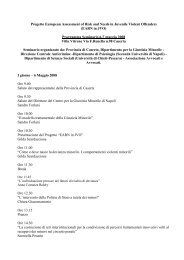Scarica il documento - Dipartimento per la Giustizia Minorile
Scarica il documento - Dipartimento per la Giustizia Minorile
Scarica il documento - Dipartimento per la Giustizia Minorile
You also want an ePaper? Increase the reach of your titles
YUMPU automatically turns print PDFs into web optimized ePapers that Google loves.
speciale<br />
166<br />
the spirit of Mi is characterized by:<br />
• Motivation to change is elicited from the client and not imposed from without.<br />
• It is the client’s task, not the counsellor’s to articu<strong>la</strong>te and resolve his or her ambivalence.<br />
• Direct <strong>per</strong>suasion is not an effective method for resolving ambivalence.<br />
• The counselling style is directive in helping the client to examine and resolve ambivalence.<br />
• Readiness to change is not a client trait, but a fluctuating product of inter<strong>per</strong>sonal<br />
interaction.<br />
• The re<strong>la</strong>tionship between counsellor and client is more like a partnership or companionship<br />
than having ex<strong>per</strong>t and recipient roles.<br />
the principles are:<br />
• Avoid discussion.<br />
• Roll with resistance.<br />
• Express empathy.<br />
• Support self-efficacy.<br />
• Reflect selectively (i.e. reflection that is mainly directed at issues that can be motivating<br />
for the desired change of behaviour).<br />
• Develop discrepancy (i.e. trying to break through the differences between the current<br />
behaviour and the exp<strong>la</strong>nation the client gives for this behaviour).<br />
and <strong>la</strong>st but not least the basic or micro sk<strong>il</strong>ls of Mi are:<br />
• Giving attention.<br />
• Open-ended questions.<br />
• Active and reflective listening at four levels (repeating, rephrasing, paraphrasing<br />
and reflecting of feelings).<br />
• Affirming.<br />
• Summarizing in an organizing way.<br />
Within Mi motivation is not seen as a mental situation wherein a <strong>per</strong>son is motivated<br />
or not (compare with a light switch that is ‘on’ or ‘off’) and neither as a <strong>per</strong>sonal trait. in<br />
Mi counsellors make use of the Cycle of Change developed by prochaska & diclemente.<br />
in the conception of prochaska & diclemente motivation is seen as a dynamic, cyclical process<br />
that can be influenced. this cycle consists of six stages of change that can be passed<br />
through several times:<br />
1) precontemp<strong>la</strong>tion: the client is not (yet) aware of having a problem; s/he denies<br />
having a problem and is not motivated for change.<br />
2) Contemp<strong>la</strong>tion: the client is not happy with the current behaviour but has not yet<br />
decided to change.<br />
3) determination: the client decides that s/he has to change but has not yet started<br />
any action towards change.<br />
4) action: the client has started action towards change.<br />
5) Maintenance: the client has changed and is trying to maintain the new behaviour.<br />
6) re<strong>la</strong>pse: the client re<strong>la</strong>pses into the former behaviour.





